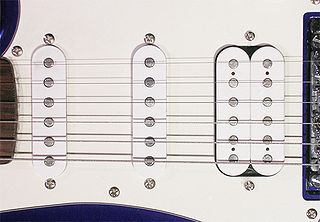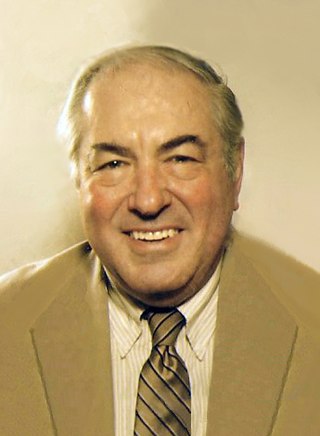Related Research Articles

Digital Audio Tape is a signal recording and playback medium developed by Sony and introduced in 1987. In appearance it is similar to a Compact Cassette, using 3.81 mm / 0.15" magnetic tape enclosed in a protective shell, but is roughly half the size at 73 mm × 54 mm × 10.5 mm. The recording is digital rather than analog. DAT can record at sampling rates equal to, as well as higher and lower than a CD at 16 bits quantization. If a comparable digital source is copied without returning to the analogue domain, then the DAT will produce an exact clone, unlike other digital media such as Digital Compact Cassette or non-Hi-MD MiniDisc, both of which use a lossy data-reduction system.

An audio tape recorder, also known as a tape deck, tape player or tape machine or simply a tape recorder, is a sound recording and reproduction device that records and plays back sounds usually using magnetic tape for storage. In its present-day form, it records a fluctuating signal by moving the tape across a tape head that polarizes the magnetic domains in the tape in proportion to the audio signal. Tape-recording devices include the reel-to-reel tape deck and the cassette deck, which uses a cassette for storage.

JVC is a Japanese brand owned by JVCKenwood. Founded in 1927 as the Victor Talking Machine Company of Japan and later as Victor Company of Japan, Ltd., the company was best known for introducing Japan's first televisions and for developing the Video Home System (VHS) video recorder.

Ampex Data Systems Corporation is an American electronics company founded in 1944 by Alexander M. Poniatoff as a spin-off of Dalmo-Victor. The name AMPEX is a portmanteau, created by its founder, which stands for Alexander M. Poniatoff Excellence. Ampex operates as Ampex Data Systems Corporation, a subsidiary of Delta Information Systems, and consists of two business units. The Silicon Valley unit, known internally as Ampex Data Systems (ADS), manufactures digital data storage systems capable of functioning in harsh environments. The Colorado Springs, Colorado, unit, referred to as Ampex Intelligent Systems (AIS), serves as a laboratory and hub for the company's line of industrial control systems, cyber security products and services and its artificial intelligence/machine learning technology.
Nakamichi Corp., Ltd. is a Japanese consumer electronics brand that originated in Japan and gained a name from the 1970s onwards for original and high quality audio cassette decks. Nakamichi is a subsidiary of Chinese holding company Nimble Holdings.

Wire recording, also known as magnetic wire recording, was the first magnetic recording technology, an analog type of audio storage. It recorded sound signals on a thin steel wire using varying levels of magnetization. The first crude magnetic recorder was invented in 1898 by Valdemar Poulsen. The first magnetic recorder to be made commercially available anywhere was the Telegraphone, manufactured by the American Telegraphone Company, Springfield, Massachusetts in 1903.
Clevite, Inc. was a Cleveland, Ohio based manufacturing company, founded as the Cleveland Graphite Bronze Company. The company was a leading producer of Babbit bearings and a significant US government defense contractor. The bearings were licensed in Britain to Vandervell Products Ltd; W. A. Robotham of Rolls-Royce said that "it was an exceedingly difficult task for Tony Vandervell ... knowing the American company well".

A pickup is a transducer that captures or senses mechanical vibrations produced by musical instruments, particularly stringed instruments such as the electric guitar, and converts these to an electrical signal that is amplified using an instrument amplifier to produce musical sounds through a loudspeaker in a speaker enclosure. The signal from a pickup can also be recorded directly.
Shure Incorporated is an audio products corporation headquartered in the USA. It was founded by Sidney N. Shure in Chicago, Illinois, in 1925 as a supplier of radio parts kits. The company became a consumer and professional audio-electronics manufacturer of microphones, wireless microphone systems, phonograph cartridges, discussion systems, mixers, and digital signal processing. The company also manufactures listening products, including headphones, high-end earphones, and personal monitor systems.
Bang & Olufsen (B&O) is a Danish high-end consumer electronics company that designs and manufactures audio products, television sets, and telephones, originally from Denmark, founded in 1925 by Peter Bang and Svend Olufsen, who designed a radio to work with alternating current, a product of significance at a time when most radios were still running on batteries. Bang & Olufsen are also known for contributing to make speakers for Ford cars such as the Ford Puma.
Semi Joseph Begun, usually referred to as S. Joseph Begun, was a German-American engineer and inventor known for his contributions to magnetic recording, underwater acoustics, and telecommunications.

Sound recording and reproduction is the electrical, mechanical, electronic, or digital inscription and re-creation of sound waves, such as spoken voice, singing, instrumental music, or sound effects. The two main classes of sound recording technology are analog recording and digital recording.
The history of sound recording - which has progressed in waves, driven by the invention and commercial introduction of new technologies — can be roughly divided into four main periods:

The Webster Chicago Corporation was a maker of electronic equipment in Chicago, Illinois. Many products were sold under the brand name Webcor. The product line included record changers, wire recorders and reel to reel tape recorders.
EICO was a manufacturer of electronics kits located in New York City, New York, United States.
The Astatic Corporation is a commercial audio products manufacturer founded in Youngstown, Ohio in 1933. Astatic formed CAD Professional Microphones in 1988 as a division of Astatic. The company reorganized as Omnitronics LLC in 2000, and later combined CAD, Astatic and Omnitronics under the CAD Audio brand. DAS Companies purchased the rights for Astatic Citizens Band hand microphones and is one of their acquired brand names.

David Dudley Bloom was an American businessman who made notable contributions to the consumer products industry as a conceptual inventor and marketing executive during the 1950s and 1960s, including proposing and designing the first conventional travel luggage built on wheels; marketing the first "magic milk bottle" for dolls; and designing and marketing a continuous-play tape recorder.
The following timeline tables list the discoveries and inventions in the history of electrical and electronic engineering.

Gábor Kornél Tolnai was a Hungarian-Swedish engineer and inventor. He is best known for his inventions and patents for spinning machines, devices for the Swedish National Defense and several types of tape recorders.
References
- 1 2 3 4 "Brush". museumofmagneticsoundrecording.org. Museum of Magnetic Sound Recording. Retrieved February 8, 2022.
- 1 2 3 http://www.audiotools.com/dead_b.html Audiotools: Defunct Audio Manufacturers
- ↑ "BRUSH DEVELOPMENT CORP. – The Encyclopedia of Cleveland History". Case Western Reserve University. Retrieved December 6, 2012.